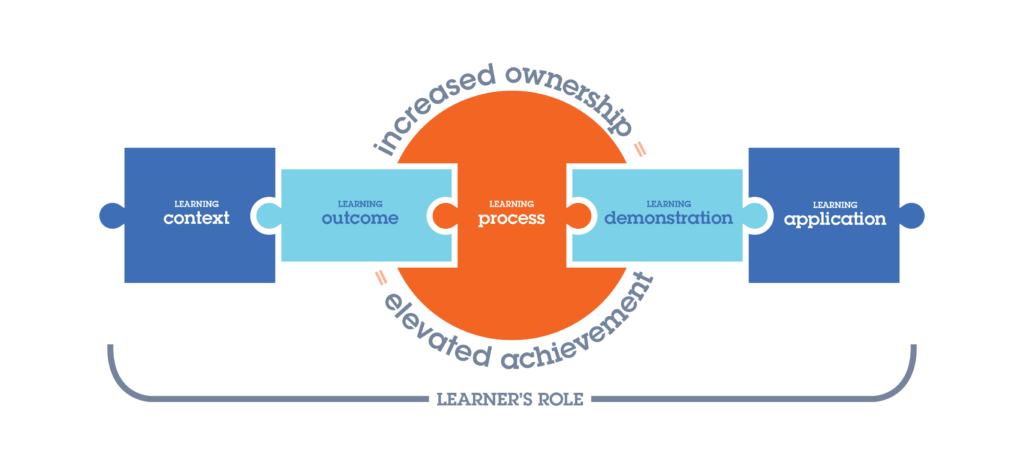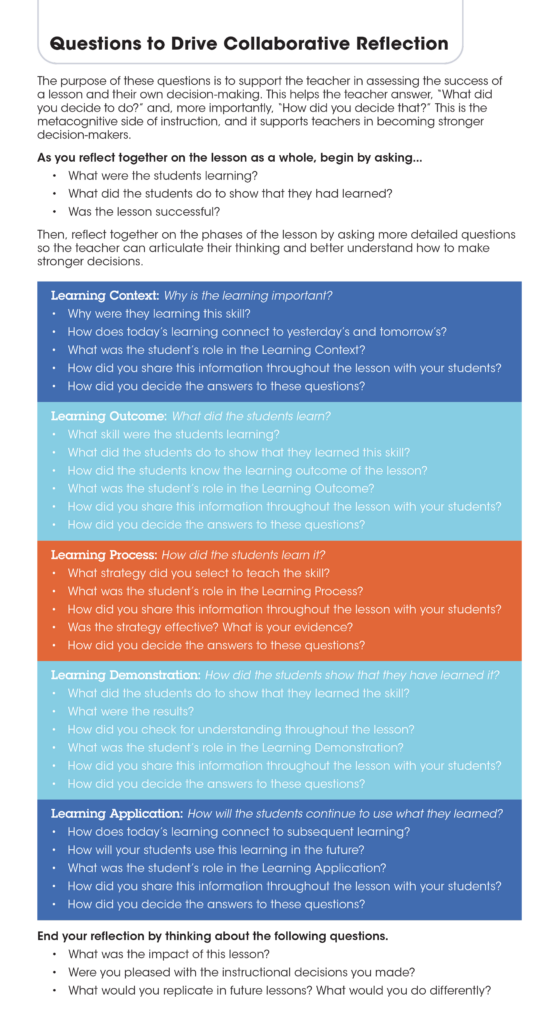Share this article.
Reflection implies an individual practice. But, it is a process that requires and deserves support from the school-site administration for the collective school community. This support includes providing opportunities for teachers to implement practices specific to their identified areas of growth. It includes creating an environment that promotes risk-taking, collaboration, and time for guided reflection. And it includes exemplifying models of practice and of reflection that develop the mindful habit of continual self-reflection and improvement.
We promised, in another article, to provide the rationale and the tools for this kind of collegial support for teachers and their reflections and here it is.
Why Reflection Must Be Collaborative
As educators, we know the impact meaningful conversations have on learning. We know that the more opportunities students have to share ideas, clarify their thinking with others, make mistakes as they are talking, and force themselves to solidify their understanding, the greater probability they have to learn the content or skills at a deeper level. This is metacognition, and it requires learners to examine, externalize, and apply their thinking, such as:
- What it means to learn something,
- Awareness of one’s strengths and weaknesses with specific skills or in a given learning context,
- Planning what’s required to accomplish a specific learning goal or activity,
- Identifying and correcting errors, and
- Preparing ahead for learning processes. (Chick, 2017)
Metacognition is related to the concept of learnership—a mindset that leads to elevated academic achievement and that teachers can develop in themselves and in their students. It is the critical thinking skills that empower students to think about, question, and communicate new learning in lasting ways. (Zwiers & Crawford, 2011)
The same is true for teachers. Teachers who think critically about the success of a lesson and how their decisions impacted that success, in turn, will have a positive impact on teaching and learning for their students. This is the metacognitive side of instruction, and it supports teachers in becoming stronger decision-makers.
But, although, reflection implies a solitary, internal method, we’ve found that the power of reflection is amplified when meaningful conversations are part of the process. When teachers have the opportunity to talk about their lessons with a colleague, insights are gained, skills are refined, and students benefit. This can only happen if teachers are supported to talk about and therefore build metacognition around their decisions: how they are making them, why they are making them, and the impact these changes are having on student learning.
To that end, the most effective method to support stronger teachers’ decision-making is through a question-driven process.
A Question-Driven Process for Collaborative Reflection
A question-driven reflection is a method of discourse that allows a teacher to own the reflection process by explaining, clarifying, and reflecting on the decisions they made in planning and delivering the lesson. The collaboration can be facilitated as peer-to-peer, teacher-to-mentor, and teacher-to-administrator. It requires one colleague in the role of the questioner and the other in the role of the teacher who is reflecting on their lesson.
The reflection is driven by broad questions that support the teacher in assessing the success of their lesson and their own decision-making. This helps the teacher answer, “What did you decide to do?” and, more importantly, “How did you decide that?”
Telling or asking closed questions saves people from having to think. Asking open questions causes them to think for themselves. (Whitmore, 2017)
In other words, a question-driven collaboration helps teachers become more effective and efficient decision-makers regarding classroom practice because, when teachers reflect on and discuss how they make decisions, they are supporting their metacognition through the articulation of their thinking.
Questions should begin with broad brushstrokes and then increasingly focus on the details, always eliciting from the teacher the decisions made and the reasoning behind each decision. This questioning for more detail maintains the focus of the conversation.
The value of this process is in the conversation. The open-ended questions drive a thoughtful conversation that allows the teacher to articulate, clarify, question, and solidify the decisions they are making. This in turn supports their collaborative colleague as peers will learn from one another and mentors and administrators can better learn how to support the teacher in the future.
Questions to Drive Reflection at the Lesson Level
Madeline Hunter tells us that teaching is a constant stream of decisions made before, during, and after interactions with students. Each lesson must be driven by the learner, the learning outcome of the lesson, and how the learner is supported to own their learning. Elevated Achievement recommends using a focused Learning Model to plan and deliver effective lessons. The Learning Model is made up of five student-centered phases. The Learning Model supports effective lessons by ensuring teachers answer the following questions for themselves and sharing their answers with their students. Thereby, ensuring that students are clear about their role in learning and increasing the probability of learning.
- Setting the Learning Context: Why is the learning important?
- Stating the Learning Outcome: What will the students learn?
- Engaging in the Learning Process: How will the students learn it?
- Producing the Learning Demonstration: How will the students demonstrate that they learned it?
- Implementing the Learning Application: How will the students continue to use what they have learned?
Here are questions that collaborative colleagues can utilize reflect together and build understanding and metacognition about the decisions a teacher made at the lesson level.
Make Collaborative Reflection a Part of Your School Culture
Teachers play a crucial role in ensuring that students receive the positive effects of a well-implemented student-focused initiative. The teacher is the key decision-maker for establishing effective learning design before, during, and after instruction. Because the teacher is the person who knows the most about the students, it is important that the teacher’s ownership in making these decisions is cultivated by peers, mentors, and administrators. This is collaborative reflection.
When collaborative reflection becomes routine in a school, it creates a culture that promotes self-evaluation on teaching and learning as a support for teachers. It creates a culture that doesn’t just value self-evaluation but develops and demands it. It creates a culture where teachers are empowered to become better decision-makers for their students.
We strive to develop students that can evaluate their own learning and become lifelong learners. Don’t we want the same for our teachers? Don’t we want a culture that allows all teachers to be active participants in and control more of their own teaching and learning? Shouldn’t we have a culture that allows all teachers to receive the support needed to be lifelong learners? We believe we not only should but we must, and the first step is implementing collaborative reflection.
Continue the Learning
Check out these articles and resources to continue your learning about this topic…
The Learning Brief
In this article you learned…
- The power of reflection is amplified when meaningful conversations are part of the process because when teachers have the opportunity to talk about their lessons with a colleague, insights are gained, skills are refined, and students benefit.
- A question-driven reflection is a method of discourse that allows a teacher to own the reflection process by explaining, clarifying, and reflecting on the decisions they made in planning and delivering the lesson.
- A set of reflection questions that collaborative colleagues can utilize to begin to reflect on and understand the decisions a teacher made at the lesson level.
Can you imagine building an environment full of motivated, engaged, and eager students who own their learning?
We can.



